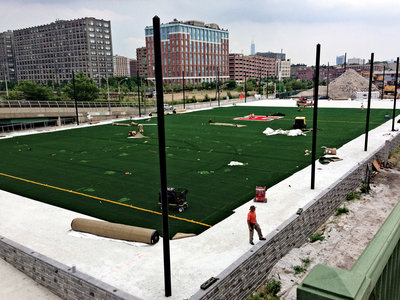Mayor Dawn Zimmer and other city officials announced last week that they will hold a ribbon-cutting ceremony on Tuesday to celebrate the opening of the athletic field at 1600 Park, the first completed phase of a larger project that will eventually include passive recreation, boating, and a playground.
The ribbon cutting will take place at 4 p.m. on Tuesday at the field, which is located on 16th Street between Park and Willow avenues.
The field, which has been planned since 2006 when the city purchased the land, will provide space for soccer, baseball, and lacrosse, as well as just about any other sport imaginable, including hurling, a popular Irish sport enjoyed by many Hobokenites.
“I think this is going to be big for residents of uptown Hoboken, but also for every resident of Hoboken.” – Dawn Zimmer
____________
A traffic light was recently installed at the corner of Park Avenue and 16th Street to increase pedestrian safety for those heading to and from the field, said Zimmer in an interview.
“I think this is going to be big for residents of uptown Hoboken, but also for every resident of Hoboken,” said Zimmer. “We’ve got 700 kids in recreation programs and not a lot of places to let them play, so this is a great thing for them.”
Former Mayor David Roberts, under whom the process to build the park began, thanked Zimmer for her work completing the project, as well as the various community groups and city officials involved.
“This park was an effort that was put together by good people who strongly believe that what the people of this city needed and wanted was more public park space,” he said. “It will be a great benefit to Hoboken’s young people.”
The entirety of the first phase cost around $2.1 million to construct, said the city’s Director of Redevelopment, Brandy Forbes.
A long road to here
The plan to build 1600 Park began in 2006, when a group called the Hoboken Parks Organization formed in objection to a zoning variance that was about to be granted to a developer wishing to build two residential towers there. The group, lead by Leah Healy, advocated against the variance, and the Zoning Board listened.
Later, the space was included in a citywide master plan as an area ideal for recreation, and that same year, it was purchased for the city for about $7 million. The city put up some of the cost, but the majority of it was covered by the Trust for Public Land, a national nonprofit that engages in business deals with property owners on behalf of cities wishing to construct open space projects. Further funding was provided by the state and the county.
Some crucial steps were completed by the Roberts administration, but the park didn’t really start to gain momentum until 2010, when Zimmer and her team began holding public forums to decide what the best uses for the space would be. Healy said that her organization advocated heavily for active recreation fields.
“When we were working on the master plan, we became aware that a lot of kids who played sports here were playing until 10 p.m. because there weren’t enough fields,” she said. “We felt that an athletic space would be an important thing.”
There were some environmental issues that followed, including worries over whether a full soil remediation would have to be completed before construction could start, said Forbes. The Department of Environmental Protection (DEP) eventually decided against the remediation, but said that the city would have to put two feet of soil on top of the field before construction. The city agreed, but later proposed using artificial turf instead. DEP agreed, and the city decided to use the soil to build a raised foothill at the field’s northern end, which can now be used for observing the field.
b>The future and Hoboken Cove
There are plans to connect 1600 Park and what has become known as Hoboken Cove, a small pebble beach north of 16th Street on the river. The connection would result in a massive uptown park space, complete with a boathouse, playground and various lawns reminiscent of Pier C’s futuristic design.
The city is currently seeking funding to complete the second phase of the project, which will include the boathouse. With the boathouse, the Hoboken Kayak Club as well as private kayakers and canoers could store their boats by the water, rather than have to transport them, said Zimmer. There would also be expanded access for the sailing team at Stevens Institute of Technology.
Zimmer said that the plans for the expanded park would also involve looking into whether any flood resilience measures could be worked into the existing plans. The bids that the city requested from contractors, she said, involved a request for a company that had worked with green infrastructure and flood resiliency.
Healy said that the bigger the city can make the park, the better it would be for Hoboken residents.
“Our mission is to make sure all the spaces designated as possible parks in the master plan actually become parks,” she said. “1600 Park is a great first step.”
Dean DeChiaro may be reached at deand@hudsonreporter.com
